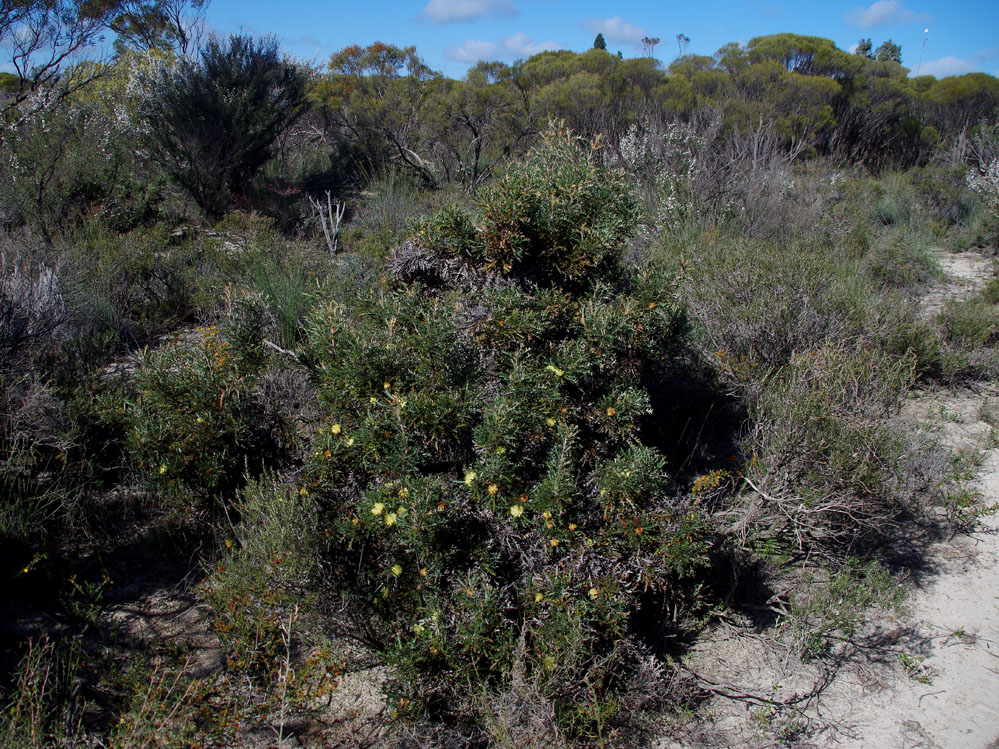Banksia Purdieana on:
[Wikipedia]
[Google]
[Amazon]
 ''Banksia purdieana'' is a species of bushy shrub that is
''Banksia purdieana'' is a species of bushy shrub that is
 ''Banksia purdieana'' is a species of bushy shrub that is
''Banksia purdieana'' is a species of bushy shrub that is endemic
Endemism is the state of a species being found only in a single defined geographic location, such as an island, state, nation, country or other defined zone; organisms that are indigenous to a place are not endemic to it if they are also foun ...
to Western Australia. It has broadly linear, pinnatipartite leaves with sharply-pointed lobes on the sides, yellow flowers in heads of about eighty and egg-shaped follicles.
Description
''Banksia purdieana'' is a bushy or column-shaped shrub that grows to high and up to wide but does not form alignotuber
A lignotuber is a woody swelling of the root crown possessed by some plants as a protection against destruction of the plant stem, such as by fire. Other woody plants may develop basal burls as a similar survival strategy, often as a respons ...
. It has curved, broadly linear, pinnatipartite leaves that are long and wide with between four and seven triangular, sharply-pointed teeth on each side. The flowers are yellow and are arranged heads of about eighty with elliptical to linear involucral bracts
In botany, a bract is a modified or specialized leaf, associated with a reproductive structure such as a flower, inflorescence axis or cone scale.
Bracts are usually different from foliage leaves in size, color, shape or texture. They also look ...
up to long at the base of the head. The perianth
The perianth (perigonium, perigon or perigone in monocots) is the non-reproductive part of the flower. It is a structure that forms an envelope surrounding the sexual organs, consisting of the calyx (sepals) and the corolla (petals) or tepal ...
is long and the pistil
Gynoecium (; ; : gynoecia) is most commonly used as a collective term for the parts of a flower that produce ovules and ultimately develop into the fruit and seeds. The gynoecium is the innermost whorl (botany), whorl of a flower; it consists ...
long and curved. Flowering occurs from July to September and the follicles are egg-shaped with a notch at the base and long.
Taxonomy and naming
This species was first formally described in 1904 byLudwig Diels
Friedrich Ludwig Emil Diels (24 September 1874 – 30 November 1945) was a German botanist.
Diels was born in Hamburg, the son of the classical scholar Hermann Alexander Diels. From 1900 to 1902 he traveled together with Ernst Georg Pritzel thro ...
who gave it the name ''Dryandra purdieana'' and published the description in the journal ''Botanische Jahrbücher für Systematik, Pflanzengeschichte und Pflanzengeographie''. The specific epithet
In Taxonomy (biology), taxonomy, binomial nomenclature ("two-term naming system"), also called binary nomenclature, is a formal system of naming species of living things by giving each a name composed of two parts, both of which use Latin gramm ...
(''purdieana'') honours Diels's friend Alexander Purdie.
In 2007 Austin Mast and Kevin Thiele transferred all dryandras to the genus ''Banksia'' and renamed this species ''Banksia purdieana''.
Distribution and habitat
This banksia grows in kwongan between Tathra National Park, Mogumber, Cadoux, Moorine Rock and Bendering in theAvon Wheatbelt
The Avon Wheatbelt is a bioregion in Western Australia. It has an area of . It is considered part of the larger Southwest Australia savanna ecoregion.
Geography
The Avon Wheatbelt bioregion is mostly a gently undulating landscape with low rel ...
, Coolgardie, Geraldton Sandplains
Geraldton Sandplains is an Interim Biogeographic Regionalisation for Australia, interim Australian bioregion of Western Australia. It has an area of . The Geraldton Sandplains is part of the larger Southwest Australia savanna ecoregion, as asses ...
, Jarrah Forest and Mallee biogeographic regions.
Conservation status
''Banksia purdieana'' is classed as "not threatened" by the Western Australian Government Department of Parks and Wildlife.References
{{Taxonbar, from=Q4856685 purdieana Plants described in 1904 Taxa named by Ludwig Diels